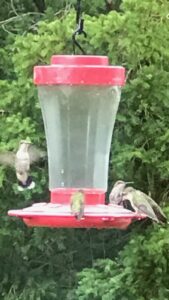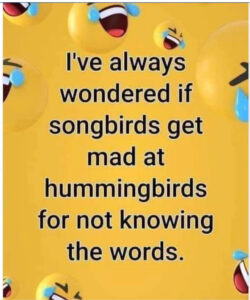One of the most amazing and interesting creatures of the bird world are Hummingbirds! It’s so fun to watch their crazy antics and see how they take turns (sometimes not so politely!!) at the feeders! This DIY Hummingbird food is so easy to make there’s no need to spend the extra money at the store for premade! It only takes 2 simple ingredients. So why spend extra money on store-bought stuff when you can easily and quickly make it in your own kitchen for much less cost!
DIY Hummingbird Food can be made in small or large batches, all depending on how many feeders you have. The more you have, the more birds you will attract. Here’s how simple it is:
- 2 cups water
- 1/2 cup white sugar (For the first couple of weeks after the birds first arrive, I increase the sugar to 3/4 cups to boost the sweetness. They are just arriving after a very long migration so this helps them get established again at our feeders while they recover from their flight.)
DIRECTIONS:
Simply combine both water and sugar in a pan and heat until the sugar dissolves. I usually heat it until bubbles begin to form on the bottom of the pan just before the boiling point. But I try to stop the process and take it off the heat before it boils much. (If you boil the liquid more than a minute or so, the birds won’t drink it very well.) Then be sure to allow the nectar cool and finally, fill your feeders! Do NOT put any food coloring in the water! Food color is actually a slow poison to birds. And they are attracted to the colors of the feeder so there’s no need to color the nectar as well.
Color Tells All
You will notice the male hummingbirds arrive first at your feeder. They are the brighter colored birds and usually have a brightly colored throat. The bodies of the females are not nearly as brightly colored and they do not sport the bright color on their neck area. In the bird world, the males are the prettiest ones! As their migration nears its destination, the males arrive first as they scout out areas to bring their families that will provide the food and shelter they will need. The females and the young follow and arrive just a few days later. There can be several families that share the same area and the same feeders.
Be sure to clean the feeders in-between fillings. The feeders tend to get pretty dirty from the hummingbird’s feet. So I have an old bottle brush that I use just for cleaning the feeders between fillings. This recipe is so good that our hummingbird families can drain our 3 feeders in 1 – 2 days!!
This recipe can easily be made in larger batches and the extra kept in the refrigerator. When we begin to see more and more of our hummer families come to stay and we begin to get warmer weather (usually in June), I will make enough nectar to fill the feeders as well as extra to keep in the fridge. That way, in a day or two, when the most popular feeder is fully drained, I can quickly clean it and refill it with the extra nectar. Then I have time to make another batch and let it cool before the other feeders are ready to be filled.
What Do Hummingbirds Eat?
Hummingbirds need food beyond the nectar they like to drink from our feeders. These small creatures must consume about 1/2 its weight in sugar each day and the average hummingbird feeds 5 – 8 times each hour. They dine on small insects they catch in the air as they fly as well as spiders. Tree sap or juice from broken fruits are also a part of their daily diet. The insects provide the food protein they need daily while the nectar provides the energy they need to fly.
Hummingbirds lick the nectar with long fringed, forked tongues. Moving capillaries that lay along the edge of their tongue help to draw the nectar up into their throats so that they can swallow.
A hummingbird licks 10 to 15 times each second while feeding. The natural sucrose that is found in floral nectar is most easily digested. And within 20 minutes the sugar is converted into energy with 97% efficiency.
10 Interesting Facts About Hummingbirds
- The hummingbird’s wings make a humming sound when they beat so fast. Hence, the name!
- Hummingbirds are the smallest migrating bird. While other birds travel in flocks, hummers usually travel by themselves flying as much as 500 miles at a time.
- These tiny creatures are the only bird that can fly backwards.
- Hummingbirds do not smell. So they can’t smell the nectar in the feeders but are drawn to them by sight and the colors of your feeders. They have good color vision. Different species of hummingbirds are attracted to different color flowers. The Ruby-throated hummingbird, the one we most commonly see here in the mid-west part of the United States, is attracted mostly to orange and red flowers. I try to plant some pots of flowers that are these colors and scatter them around the deck to help attract them.
- The average hummingbird weighs less than a nickel.
- Hummingbirds can’t walk or hop. They use their tiny legs only for perching and moving sideways while they are perched.
- They can consume as much as double their body weight each day. And they drink the nectar in the feeders by moving their tongue in and out about 13 times a second!
- Hummingbird eggs are very small – about the size of a jelly bean or a coffee bean. And the female lays an average of 2 eggs.
- A flock of hummingbirds can have several names – a Bouquet, a Flattering, a Hover, a Shimmer, or a Tune.
- And finally, there are more than 330 species of hummingbirds in North America and South America.
Migration
The maximum forward flight speed is 30 miles an hour. And the hummingbird’s wings beat between 50 and 200 flaps a second depending on the direction of their flight, the purpose of the flight and the air conditions as they fly. The Ruby-throated hummingbird flies 500 miles nonstop across the Gulf of Mexico during its spring and fall migrations. It has long been thought that these little guys “ride” on the back of other birds to help them get across the Gulf. But this is a myth! They fly the whole 500 mile distance entirely on their own!!
Species that nest farther north begin their migration south as early as mid-July. Depending on the route and the exact species, by early September, they have all headed south for their long trip across the Gulf of Mexico.
Other Fun Facts About Hummingbirds
The average lifespan of a wild hummingbird is 3 to 12 years. When these tiny creatures are resting, the take an average of 250 breaths per minute. And while they are in flight, their breathing pace is much greater.
Even though they are a small bird, they are known as one of the most aggressive bird species! They regularly attack much larger birds such as jays, crows, and hawk that invade the hummingbirds’ territory. If you watch your family of hummingbirds around your backyard feeders, you will most likely notice that there will be a dominant bird that tends to guard all the feeders and chase the other hummers away.
Dive Bombing Antics
As you watch your Bouquet of hummingbird families who have chosen to spend the summer at your backyard feeders, you may sometimes see a male hummer dive bomb other hummingbirds usually while they are at the feeders. It’s easy to think that they are attacking or trying to scare off other hummers to try to keep the feeder for themselves. But this isn’t the case! What you are witnessing is actually part of their mating ritual.
The males will fly straight up climbing high into the air, rocket-style, and then they turn to begin their nosedive! They zoom down at an amazing diving speed of up to 60 miles an hour, belting out sharp squeaks or trills to impress females that are watching the dive. At the bottom of their dive, there’s a loud chirp that actually comes from their tail feathers and not their throats. These dives are meant to impress the females!
Hummingbirds almost never stop moving! Spending most all their time in the air. They typically don’t walk much at all because their legs are so weak and small.
Hummingbirds Have Great Memories!
And perhaps most amazing of all, studies have shown that hummingbirds can remember EVERY flower they’ve ever visited and that includes all those they’ve stopped at during their migration routes! They can even recognize humans and remember which ones can be counted on to refill empty feeders!
So have fun this summer with making your own nectar and attracting these beautiful little birds to your yard. Hang your feeders from tree limbs as well as from shepherd hooks. The more you put out, the more hummingbirds you will attract. You will be truly amazed at how close they will come to you and how much fun you will have watching these true beauties of nature!! Enjoy a cup of this Amazing Coffee while you enjoy the aerial show around you! Nothing better on a beautiful summer morning than A Great Cup of COFFEE and nature’s beauty!



